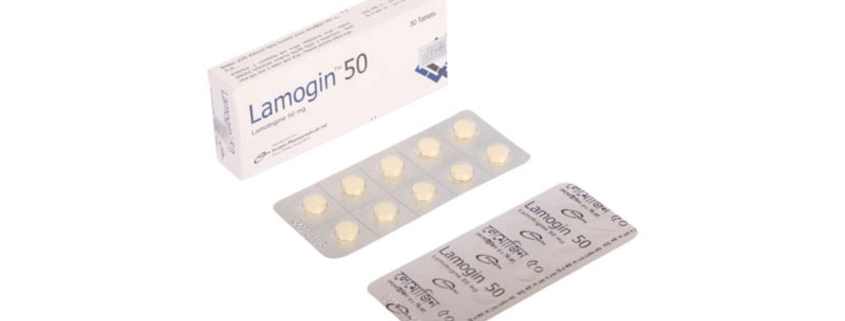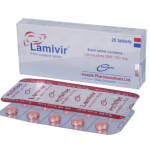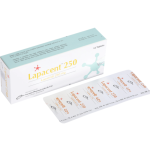Lamogin(Lamotrigine)

Therapeutic Group: Drugs of Nervous System
Presentation
Lamogin 2: Each chewable/dispersible tablet contains Lamotrigine BP 2 mg.
Lamogin 5: Each chewable/dispersible tablet contains Lamotrigine BP 5 mg.
Lamogin 25: Each tablet contains Lamotrigine BP 25 mg.
Lamogin 50: Each tablet contains Lamotrigine BP 50 mg.
Description
The precise mechanism(s) by which lamotrigine exerts its anticonvulsant action are unknown. Lamotrigine has an effect on sodium channels. Lamotrigine inhibits voltage-sensitive sodium channels, thereby stabilizing neuronal membranes and consequently modulating presynaptic transmitter release of excitatory amino acids (e.g.glutamate and aspartate).
The mechanisms by which lamotrigine exerts its therapeutic action in bipolar disorder have not been established.
Indications
Lamotrigine is indicated for:
i) Epilepsy-combination therapy in patients aged 2 years and older:
• partial-onset seizures
• primary generalized tonic-clonic seizures
• generalized seizures of Lennox-Gastaut syndrome
ii) Epilepsy-monotherapy in patients aged 16 years and older
iii) Adults with Bipolar Disorder
Dosage & Administration
 Epilepsy
Table-1: Escalation Regimen for Lamotrigine in Patients Older than 12 Years with Epilepsy
1. Weeks 1 & 2:
• In patients not taking Carbamazepine, Phenytoin, Phenobarbital, Primidone or Valproate: 25 mg every day
• In patients taking Valproate: 25 mg every other day
• In patients taking Carbamazepine, Phenytoin, Phenobarbital or Primidone and not taking Valproate: 50 mg/day
2. Weeks 3 & 4:
• In patients not taking Carbamazepine, Phenytoin, Phenobarbital, Primidone or Valproate: 50 mg/day
• In patients taking Valproate: 25 mg every day
• In patients taking Carbamazepine, Phenytoin, Phenobarbital or Primidone and not taking Valproate: 100 mg/day (in 2 divided doses)
3. Week 5 onward to maintenance:
• In patients not taking Carbamazepine, Phenytoin, Phenobarbital, Primidone or Valproate: Increase by 50 mg/day every 1 to 2 weeks
• In patients taking Valproate: Increase by 25 to 50 mg/day every 1 to 2 weeks
• In patients taking Carbamazepine, Phenytoin, Phenobarbital or Primidone and not taking Valproate: Increase by 100 mg/day every 1 to 2 weeks
4. Usual maintenance dose:
• In patients not taking Carbamazepine, Phenytoin, Phenobarbital, Primidone or Valproate: 225 to 375 mg/day (in 2 divided doses)
• In patients taking Valproate: 100 to 200 mg/day with Valproate alone
100 to 400 mg/day with Valproate and other drugs that induce glucuronidation (in 1 or 2 divided doses)
• In patients taking Carbamazepine, Phenytoin, Phenobarbital or Primidone and not taking Valproate: 300 to 500 mg/day (in 2 divided doses)
Table-2: Escalation Regimen for Lamotrigine in Patients Aged 2 to 12 Years with Epilepsy
1. Weeks 1 & 2:
• In patients not taking Carbamazepine, Phenytoin, Phenobarbital, Primidone or Valproate: 0.3 mg/kg/day in 1 or 2 divided doses
• In patients taking Valproate: 0.15 mg/kg/day in 1 or 2 divided doses
• In patients taking Carbamazepine, Phenytoin, Phenobarbital or Primidone and not taking Valproate: 0.6 mg/kg/day (in 2 divided doses)
2. Weeks 3 & 4:
• In patients not taking Carbamazepine, Phenytoin, Phenobarbital, Primidone or Valproate: 0.6 mg/kg/day (in 2 divided doses)
• In patients taking Valproate: 0.3 mg/kg/day in 1 or 2 divided doses
• In patients taking Carbamazepine, Phenytoin, Phenobarbital or Primidone and not taking Valproate: 1.2 mg/kg/day (in 2 divided doses)
3. Week 5 onward to maintenance:
• In patients not taking Carbamazepine, Phenytoin, Phenobarbital, Primidone or Valproate: The dose should be increased every 1 to 2 weeks as follows-calculate 0.6 mg/kg/day
• In patients taking Valproate: The dose should be increased every 1 to 2 weeks as follows-calculate 0.3 mg/kg/day
• In patients taking Carbamazepine, Phenytoin, Phenobarbital or Primidone and not taking Valproate: The dose should be increased every 1 to 2 weeks as follows-calculate 1.2 mg/kg/day
4. Usual maintenance dose:
• In patients not taking Carbamazepine, Phenytoin, Phenobarbital, Primidone or Valproate: 4.5 to 7.5 mg/kg/day (maximum 300 mg/day in 2 divided doses)
• In patients taking Valproate: 1 to 3 mg/kg/day with Valproate alone
1 to 5 mg/kg/day (maximum 200 mg/day in 1 or 2 divided doses)
• In patients taking Carbamazepine, Phenytoin, Phenobarbital or Primidone and not taking Valproate: 5 to 15 mg/kg/day (maximum 400 mg/day in 2 divided doses)
Table-3: The Initial Weight-Based Dosing Guide for Patients Aged 2 to 12 Years Taking Valproate (Weeks 1 to 4) with Epilepsy
1. Weeks 1 & 2:
• If the patients weight is 6.7 kg to 14 kg: 2 mg every other day
• If the patients weight is 14.1 kg to 27 kg: 2 mg every day
• If the patients weight is 27.1 kg to 34 kg: 4 mg every day
• If the patients weight is 34.1 kg to 40 kg: 5 mg every day
2. Weeks 3 & 4:
• If the patients weight is 6.7 kg to 14 kg: 2 mg every day
• If the patients weight is 14.1 kg to 27 kg: 4 mg every day
• If the patients weight is 27.1 kg to 34 kg: 8 mg every day
• If the patients weight is 34.1 kg to 40 kg: 10 mg every day
 Bipolar disorder
Table-4: Escalation Regimen for Lamotrigine in Adults with Bipolar Disorder
1. Weeks 1 & 2:
• In patients not taking Carbamazepine, Phenytoin, Phenobarbital, Primidone or Valproate: 25 mg daily
• In patients taking Valproate: 25 mg every other day
• In patients taking Carbamazepine, Phenytoin, Phenobarbital or Primidone and not taking Valproate: 50 mg daily
2. Weeks 3 & 4:
• In patients not taking Carbamazepine, Phenytoin, Phenobarbital, Primidone or Valproate: 50 mg daily
• In patients taking Valproate: 25 mg daily
• In patients taking Carbamazepine, Phenytoin, Phenobarbital or Primidone and not taking Valproate: 100 mg daily (in divided doses)
3. Week 5:
• In patients not taking Carbamazepine, Phenytoin, Phenobarbital, Primidone or Valproate: 100 mg daily
• In patients taking Valproate: 50 mg daily
• In patients taking Carbamazepine, Phenytoin, Phenobarbital or Primidone and not taking Valproate: 200 mg daily (in divided doses)
4. Week 6:
• In patients not taking Carbamazepine, Phenytoin, Phenobarbital, Primidone or Valproate: 200 mg daily
• In patients taking Valproate: 100 mg daily
• In patients taking Carbamazepine, Phenytoin, Phenobarbital or Primidone and not taking Valproate: 300 mg daily (in divided doses)
5. Week 7:
• In patients not taking Carbamazepine, Phenytoin, Phenobarbital, Primidone or Valproate: 200 mg daily
• In patients taking Valproate: 100 mg daily
• In patients taking Carbamazepine, Phenytoin, Phenobarbital or Primidone and not taking Valproate: up to 400 mg daily (in divided doses)
Side Effects
Common side effects of Lamotrigine include-dizziness, tremor, headache, rash, blurred vision, fever, lack of coordination, abdominal pain, infections, sleepiness, back pain, vomiting, diarrhea, tiredness, insomnia, dry mouth, stuffy nose, sore throat.
Precautions
Serious skin rashes, Blood Dyscrasias, Suicidal Behavior, Aseptic Meningitis can occur in both adult and pediatric population.
Use in Pregnancy & Lactation
Pregnancy: Pregnancy Category C.
Nursing mothers: Lamotrigine is excreted in human milk. Because of the potential for serious adverse reactions in nursing infants from Lamotrigine, a decision should be made whether to discontinue nursing or discontinue the drug, taking into account the importance of the drug to the mother.
Pediatric Use
The safety and effectiveness of Lamotrigine in the adjunctive treatment of partial onset seizures in pediatric patients’ age 1 month to 24 months old with epilepsy have been established.
Pediatric Use
Epilepsy: Safety and effectiveness of Lamotrigine used as adjunctive treatment for partial onset seizures were not demonstrated in very young pediatric patient’s aged 1 to 24 months.
Bipolar Disorder: Safety and effectiveness of Lamotrigine for the maintenance treatment of bipolar disorder were not established in pediatric patient’s aged 10 to 17 years.
Drug Interaction
Lamotrigine interacts with Oral contraceptives, Atazanavir/ritonavir, Carbamazepine, Levetiracetam, Lithium, Lopinavir/ritonavir , Olanzapine, Phenobarbital/primidone , Phenytoin, Pregabalin etc.
Over Dose
Overdose has resulted in ataxia, nystagmus, seizures (including tonic-clonic seizures), decreased level of consciousness, coma, and intraventricular conduction delay.
Commercial Pack
Lamogin 2: Each box contains 3 blister strips of 10 tablets.
Lamogin 5: Each box contains 3 blister strips of 10 tablets.
Lamogin 25: Each box contains 3 blister strips of 10 tablets.
Lamogin 50: Each box contains 3 blister strips of 10 tablets.
Others
Drug Interaction
Lamotrigine interacts with Oral contraceptives, Atazanavir/Ritonavir, Carbamazepine, Levetiracetam, Lithium, Lopinavir/Ritonavir, Olanzapine, Phenobarbital/Primidone , Phenytoin, Pregabalin etc.



